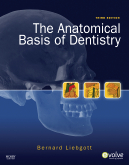|
|
|
| |
 |
|
|

|
 推薦指數:
推薦指數:





|
|
- 內容介紹
|
The Anatomical Basis of Dentistry, 3rd Edition
By Bernard Liebgott, DDS, MScD, PhD
528 pages
Trim Size 8 3/4 X 11 1/16 in
Copyright 2010
Description
Now in full color, The Anatomical Basis of Dentistry helps you master the essentials of gross anatomy! Complete, accurate coverage highlights the regions of the head and neck that are of clinical relevance. Core information provides a foundation of knowledge essential to providing a successful chairside experience for both you and the patient. Using a clear, accessible style, with practical Clinical Notes boxes, this book closely relates the basic science of applied anatomy to the clinical practice of dentistry.
Key Features
A focus on core information specifically highlights the regions of the head and neck along with the abdomen and thorax, serving as a foundation for the other basic sciences and for subsequent clinical courses.
Coverage of applied anatomy draws correlations between the basic science of anatomy and clinical practice of dentistry.
General Concepts chapter includes anatomical terminology and provides a general description of each body system in preparation for the regional anatomy topics that follow.
A regional approach reflects the order in which the regions are commonly taught, by showing structures representing several systems -- which parallels the manner in which structures are encountered in patients.
Full-color cadaver dissection photos clearly depict the location of anatomic structures, showing anatomical details impossible to view in clinical examination.
Chapters on limbs provide a more complete picture of the body, covering areas that may be possible sites for intravenous and intramuscular injections.
Applied Anatomy chapter relates anatomy to the clinical practice of dentistry, covering topics such as the anatomy of local anesthesia, imaging (including intraoral, extraoral, and MRI), fractures of the face, and the spread of dental infection.
Clinical Notes boxes relate basic science concepts to actual scenarios that may be encountered in clinical practice.
Review questions in multiple-choice format help you assess your understanding and provide good preparation for the NBDE.
New to this Edition
Full-color photos and drawings clearly demonstrate core concepts and reinforce important principles.
New information on the back enhances your understanding of body systems with coverage of the surface features of the back, movements of the spine, and a new Clinical Notes box on back strain.
New information on the neck includes the movements of the head and neck, and a new table detailing the muscles responsible for those movements.
Added coverage of applied anatomy includes a new section with illustrations of Cone Beam Computed Tomography (CBCT), a new section on Alveolar Ridge Tomography, and more images of the TMJ.
An Evolve website includes a 300-question test bank and image collection for instructors and a self-assessment exam for students.
Table of Contents
1. General Concepts
The Study of Anatomy
Terminology
Skeleton
Joints
Muscular System
Cardiovascular System
Nervous System,
Body Coverings, Body Cavities, and Fascia
2. The Back
Skeletal Parts
Surface Features of the Back
Spinal Cord
Muscles of the Back
3. The Thorax
Skeleton and Divisions
The Thoracic or Chest Wall
The Pleural Cavities and Lungs
The Mediastinum
4. The Abdomen, Pelvis, and Perineum
Skeleton and Subdivisions
The Abdominal Walls
Peritoneum and the Peritoneal Cavity
Blood and Nerve Supply to the Abdomen
The Abdominal Viscera
5. The Neck
Skeleton and Surface Anatomy
Coverings and Regions
The Anterior Triangle
The Posterior Triangle
The Root
The Suboccipital Region
The Prevertebral Region
6, The Skull
Introduction
Views
Bones
Postnatal Development
7. The Head by Regions
The Face and Scalp
The Contents of the Neurocranium
The Orbital Cavity
The Parotid Region
The Masticator Region
The Pterygopalatine Fossa
The Nasal Cavity and Paranasal Air Sinuses
The Oral Cavity
Structures and Areas of the Oral Cavity
The Pharynx
The Larynx
The Ear
8. Systemic Anatomy of the Head and Neck
Arteries
Veins
Lymphatics and Lymph Nodes
Cranial Nerves and Cranial Autonomics
9. The Upper Limb
Skeleton
Joints, Movements, and Muscles
Muscles
Axilla
Nerve Supply: The Brachial Plexus
Arterial Supply
Venous Return
Lymphatic Drainage
10. The Lower Limb
Skeleton
Joints
Muscles
Nerve Supply: The Lumbar and Sacral Plexuses
Arterial Supply
Venous Return
Lymphatics
11. Applied Anatomy
Anatomy of Local Anesthesia
Imaging
Fractures of the Face
Spread of Dental Infections
Answers to Review Questions
Index
|
|
|

